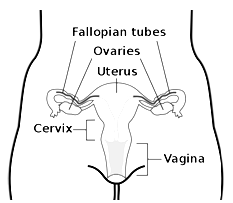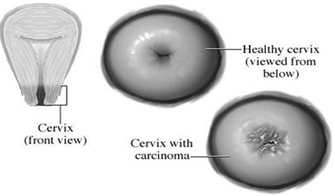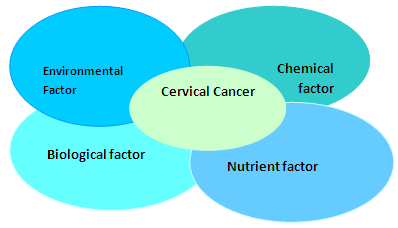About Author: Rinki Verma (Research fellow)
Institute of Medical science (CEMS)
Banaras Hindu University
Varanasi - 221005
Abstract
India, the disease accounts for an estimated 24 percent of India’s cancer cases among women and additionally 74,000 indian women die annually from the disease, which results from the abnormal growth of cells in the cervix (the narrow opening of the uterus or womb). Cervical cancer is the most common disorder among middle-aged women which increased the mortality rate in Indian rural women as compared urban due to lack of their awareness and don’t acquire appropriate education . Uncontrolled growth (cancer) in the cervix is not a single type. It is not usually associated with hereditary genetic factor but also a number of other factors (Chemical, Physical , environmental and biological ) indirectly heighten the risk of cervical cancer by increasing the likelihood that a woman will contract an HPV infection. These factors include early age at first intercourse and multiple sex partners. National Cancer Control Program emphasizes the importance of early detection and treatment. But the country has no organized screening program, and many Indian women lack information about the disease and access to prevention and treatment facilities. Therefore, it is most of important to reduced rate of women mortality through proper management.
Reference ID: PHARMATUTOR-ART-1096
I. Introduction:
India is one of the countries where women and men have the same life expectancy. But there are still problems with women’s health life expectancy in Indian women due to high rate of mortality, particularly during childhood and in their reproductive age.
The discrepancy has been noticed over the dominance on males over the females. A health problem with Indian women is intrinsically linked to their socio economic status in society also. Research on women’s status are overlooked. The socio economic factors are so strong for son dominancy which can easily be recognized by high dowry death, molestations of daughters. The best example recently we have noticed that even government fail to comprehensible the women bill in the parliament due to empowerment of male dominancy in the government. All of these factors exert a negative impact on the health status like depression. Although, Indian women’s facing most common problems in the country are hypertension, depression, heart disease, diabetes, and osteoporosis besides this tropical diseases such as malaria and filarial infection. The other severe disorders are infertility, malignancies both common, cervical cancer and breast cancer, Table-1 depict the cause of mortality rate in different part of the country due to different diseases base on socio-economic status.
Table-1. Prevalence (%) of mortality caused by cervical cancer in the country.
|
S.N |
Causes disease |
World Frequency (%) |
Low income country Frequency (%) |
Middle income country Frequency (%) |
High income country Frequency (%) |
|
1 |
Ischaemic heart disease |
12.2 |
8.7 |
14.8 |
15.8 |
|
2 |
Stroke |
11.1 |
6.1 |
16.4 |
11.2 |
|
3 |
Low respiratory infection |
7.3 |
11.4 |
0.0 |
4.0 |
|
4 |
COPD* |
5.1 |
3.3 |
7.8 |
3.1 |
|
5 |
Diarrhoeal diseases |
3.8 |
7.0 |
------ |
---- |
|
6 |
HIV/AIDS |
3.7 |
6.1 |
2.4 |
------ |
|
7 |
Diabetes mellitus |
2.3 |
----- |
2.6 |
3.0 |
|
8 |
Premature and low birth weight |
2.1 |
3.3 |
----- |
----- |
|
9 |
Neonatal infection(Pulmonary disease) |
2.0 |
3.5 |
------ |
----- |
|
10 |
Hypertensive heart disease |
1.9 |
----- |
2.8 |
2.2 |
|
11 |
Trachea,bronchus and lung cancer |
----- |
----- |
1.7 |
3.9 |
|
12
|
Colon and rectum cancer |
----- |
-----
|
----
|
1.2 |
Source WHO. *CPOD= Chronic pulmonary disease
II. What is Cervix?
The cervix (means neck in Latin) is part of a woman's reproductive system and the lower, narrow part of uterus (a hollow, pear-shaped organ), is found in a woman's lower abdomen, between the bladder and the rectum. The vagina leads to the outside of the body as shown in fig.1. During pregnancy, the cervix is tightly closed to help keep the baby inside the uterus. At the time of birth, the cervix opens to allow the baby to pass through the vagina.

Fig- 1.Human female reproductive system showing structure of cervix
III. Background Information:
Earlier age of scientific era with advantage of technology the first out growth was abnormal in the year 1930s by Scientist Dr. Richard Shope of the Rockefeller University studied wild rabbits that had developed "horns," which upon further analysis was caused by a virus that could be transmitted and later confined by malignant. This research eventually led to the discovery that cervical cancer was caused by a papillomavirus. Study was further confirmed by Dr. Shope and Dr. Harald zur Hausen's in 1980s by the using of the DNA technology.
The Greek physician in 400 B.C., Hippocrates wrote about the disease and even attempted to treat the cancer with a procedure known as the trachelectomy; through this procedure he couldn’t eliminate the cancer. Again in the 1940s, the procedure was improved in which cervix part removed from the uterus. Cancer of the uterine cervix is the second-most common malignant tumour in the World . Mostly it appears in woman aged between 50 to 55 years of an individulas.The exact cause of cervical cancer was unknown until the 20th century. After some time, scientists have been discovered the causes of cervical cancer, they found that the cervical cancer caused by exposure to the human papilloma virus (HPV).In1980s, it was declared that they are affected only in the presence of HPVs.
IV. Epidemiology:
Globally and perspectively, “epidemiology play a large role in a comprehensive cancer centre and research on women health problem to established the association between risk factors of an individual cancer and their association with other factor. Traditionally, these include case series, case–control studies, cohort studies, and intervention studies. Most studies conducted before the availability of HPV, DNA detection systems identified as key risk factors several variables including the sexual behaviour of our Indian women and of their partners. According to the most recent data, about 500,000 new cases of cervical cancer registered worldwide each year and majority of them occurs in developing countries. The women due to cervical cancer approximately 50% annually, among them > 80 % are belong to developing countries; this may be because of high cost for the treatment of identified cervical cases according to the study of World Bank in 1993.
Epidemiological study reveals the incidence varies in different part of the country of cervical cancer. Higher risk of cervical cancer has been reported in California, U.S.A, In Indian women, cervical cancer is the most common and killer disease with 126, 000 new cases registered and 70, 000 deaths occurs each year. It has been estimated that about 1,40,000 women might develop cervical cancer by the turn of this century because several risk factors like early marriages, poor sexual hygiene , growing extra-marital and pre-marital contacts .make the occurrence higher in India then Eastern Asia (Fig.2). The differential pattern of cervical cancer and the wide variation in incidence are possibly related due to environmental factors. An etiologic association and possible risk factors for cervical carcinoma have been extensively studied in India and an other part of country.

Fig.2 Prevalence of cervical cancer in the different part of world.
In many developed countries the incidence of mortality decline i.e. about 16 per 100,000 women per year in the USA. In the UK the incidence was 9.1/100,000 per year (2005), while Northern Europe, mortality decline 3.1/100,000 per year (2006). The incidence of mortality worldwide it is estimated that there are 473,000 cases of cervical cancer, and 253,500 deaths per year. Low rate between 1992 & 1996 has been observed in Quebec may reflect that the incidence rates have declined across all regions about for approximately 15% of all cancers in women and age standardized rates are three times higher than the national average. HPV estimated to cause 100% of the almost 260 000 deaths from cervical cancer worldwide in 2005 and about 80%of cancer cases attributable to HPV in developing countries The highest estimated incident cerates are in sub-Saharan Africa, Melanesia, Latin America and the Caribbean, south-central Asia and south-east Asia. All developed countries have successfully controlled their cervical cancer burden through screening and early treatment programmed.
Epidemiology of cervical cancer has shown strong associations with religious, marital and sexual patterns. It is well established that women with multiple partners and early ages at first intercourse are at high risk but less is known about how these factors how to interact or affected by specific sexual characteristics. Some studies indicate that number of steady partners and frequent intercourse at early ages may further enhance risk, supporting hypotheses regarding a vulnerable period of the cervix and a need for repeated exposure to an infectious agent. Now it is widely accepted that HPV is the major infectious etiological agent, but whether other agents play supportive or interactive roles is unclear. Some evidences reveals that viral agent may interact with HPV. Other speculative risk factors for cervical cancer include cigarette smoking, oral contraceptive usage and certain nutritional deficiencies, but again it is not clear whether these factors operate independently from HPV. In addition, a number of recent studies draw attention to the need for considering not only female influences on risk of cervical cancer, but also male factors, since the sexual behavior of the male consort appear to play an important role.
V. Types of cervical cancer (in brief):
Mainly on the basis of their origin the cervical cancer are classified in to two types - squamous cells and adenomatous cells but the majority are found in the squamous cells. Squamous cells are typical in structure and involve in the covering of cervix but the significance of cells remains unknown. The name itself indicating the cells is slightly abnormal in morphology, but not as abnormal as in case of mild dysplasia. Adenomatous cells are found in side covering of cervix to womb. According to WHO classification system, cervical cancers are mild, moderate or sever dysplasia or carcinoma in-situ (CIS). Cervical intraepithelial neoplasia (CIN) was developed in place emphasis on spectrum of abnormality in these lesions, and to help standardize treatment. In some patients progress to high-grade dysplasia are not unusual for HPV to cause but low-grade dysplasia within months or years of infection.
VI. Screening of the cancer patients:
According to the guidelines of American College of Obstetricians and Gynaecologists advise that “All women who are or who have been sexually active or who have reached age 18 should undergo an annual Pap test and pelvic examination. Various methods are available for screening of the cervical cancer but most of common traditionally develop method is the Pap smear screening test and the pelvic inspection test. During a pelvic inspection test, checking the morphological changes (abnormalities) in the size or shape of uterus, vagina, ovaries, fallopian tubes, bladder and rectum. The cervical cancer does not directly develop from normal cervix cells. Firstly, cervical cell developed a “pre-cancerous” stage (dysplasia) grow more rapidly and can be detected by pap smear .The Pap test may also notice for various diseases of infections. Pap test is not 100% accurate for screening test in morden era of science .There are various new advance techniques like conization, large loop excision of the transformation zone, endcervical curettage, liquid based cytology tests and colposcopy (biopsy).

Fig - 3. Representative views of healthy and cancerous cervix in female.
VII. Factors influencing Cervical Cancer:
There are several causative factors have been identified such as-Genital infection, Sexual Behaviour, Chemical, Dietary (Nutrition), and life style factors.
a. Biological factor:
There are various biological factors associated to the origin of cervical cancer. The most significant role played by Human papilloma virus (HPV). There are about 200 strains, but only there are 30 strains of HPV cause genital infections, which cause development of warts on the genital areas, anal areas, and cervix. One of the biggest risk factors for HPV is having unprotected sex or having multiple sex partners, as well as having sex with someone who has come into contact with the virus from another person. Those who engage in sexual activity prior to the age of 18 are also shown to be at a higher risk for HPV infection and cervical cancer later in life. The cellular by HVP infection leads to the development of abnormal structure of the cells might only be examined under close examination of a biopsy by a microscope.
b. Environmental factor:
Environmental factors exaggerated by drinking of polluted water, air, food and in the workplace may contribute to cervical cancer. According to studies on environmental causing factors for pre-cancerous lesions of the uterine cervix have shown by personal habits, as do social circumstances (high risk in developing countries), toxic agent’s, drugs due to poor hygienic condition & dietary (life style) habits influence the risk factor and strong association in the development of cervical cancer.
c. Chemicals Factor:
There are some chemicals which influence development of cancer in the cervix due to change in genetic material. The most common chemical, tars was the first chemical agent associated with cervical cancer. In America there are several cases reported on the tar-based vaginal douching, highly associated with the development of cervical cancer, through cigarette smoking represents the exposure to a tar-based cervical cancer. The cervical mucus of cigarette - smoking women contains 3 times the levels of NNK (4-(methylnitrosamino)-1-(3-pyridyl) -1- butanone) compared with the cervical mucus of non- smokers.

Fig.4: This Central dogma of the cervical cancer showing the interaction with various factors.
VIII. Treatment of Cervical Cancer:
There are several options for treatment of early stage cervical cancer. Treatment depends on age of the individual and health status including different stages of the cancer. Most common treatment at early stage of cervical cancers is radical hysterectomy (surgical removal of the cervix and uterus). If the tumour retains other features with increase the risk of the cancer will come back then further (adjuvant) treatment is recommended. The radiation therapy is another alternative which is usually given in combination with chemotherapy. Radiation therapy includes the use of high-energy x-rays to stop the growth of the cancer. Brach therapy delivers radiation from a device that is temporarily placed inside the vagina. This delivers a high dose of radiation to the area where cancer cells are most likely to be found, hopefully minimizing the effects of radiation on healthy tissues. External beam radiation therapy (EBRT) the source of the radiation is outside the body, and the area to be treated is designed carefully to limit the amount of radiation directed at healthy tissue. Brach therapy alone is adequate treatment for the earliest stage cervical cancers. Chemotherapy — most of the women who undergo EBRT for cervical cancer are also treat with chemotherapy during combination with radiation therapy.
IX. Conclusion:
Women’s health in India is highly fragile. The government and non government agencies failed to implement awareness health programmes in both rural as well as in urban population for correct diagnosis and their treatment. Cancer of cervix is important disorder in the country because of poor hygienic condition as well as social-economical factor. Timely deduction of cancer of cervix may not only reduce the mortality rate but also to reduce the incidence from secondary infections lead to infertility.
X. Acknowledgment:
Author thank the scientist: (Dr.A.K.Saxena), physician, administer and also their senior Divya singh and Jyoti gupta who support in this study of the Institute of Medical Science. Author are also grateful to Vishal seth.
NOW YOU CAN ALSO PUBLISH YOUR ARTICLE ONLINE.
SUBMIT YOUR ARTICLE/PROJECT AT articles@pharmatutor.org
Subscribe to Pharmatutor Job Alerts by Email
FIND OUT MORE ARTICLES AT OUR DATABASE









